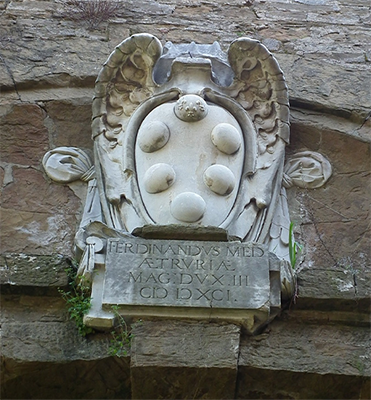
In this blog series, we will explore the most famous Italian noble families of the Middle Ages and the Renaissance and their coins. We will look at how did they rose to power, what are their heraldic symbols and some of the coins we have in our collection. In this part, we will be looking at the Medici and Farnese families, which are synonymous with Renaissance power and art patronage.
Medici of Florence
The Medici name is often a synonym for Renaissance in Italy and prolific art patronage. The House of Medici is known as a banking and political dynasty. They first came to prominence with Cosimo de’ Medici in the Republic of Florence during the first half of the 15th century. There are different origin stories of how Medici came to power and where their heraldry is derived from them. The Medici coat of arms has five red balls and one blue on a gold shield. It is prominently displayed on buildings across Tuscany that had been funded by the family. The family gave four Popes to the Catholic Church and were distinguished patrons of Brunelleschi, Botticelli, Leonardo da Vinci, Michelangelo, Raphael, Machiavelli and Galileo, financing the construction of Saint Peter’s Basilica in Rome and the cathedral of Santa Maria del Fiore in Florence.

The family originated in Mugello region of Tuscany. In 1532, the family acquired the hereditary title of Dukes of Florence. In 1569, the Duchy was elevated to the Grand Duchy of Tuscany after territorial expansion. The Medici ruled the Grand Duchy from its inception until 1737, with the death of Gian Gastone de Medici. The Grand Duchy witnessed degrees of economic growth under the early Grand Dukes, but was bankrupt by the time of Cosimo III de Medici (who reigned from 1670 to 1723).

Cosimo III de Medici was the sixth, penultimate Grand Duke of Tuscany. He had the longest reign in Tuscan history (53 years) and witnessed the economic decline of the family and the region. Upon the death of his son Gian Gastone, Tuscany passed into the hands of House of Lorraine, which was later joined the Habsburg royal family.

Farnese of parma
One of the most influential families of the Italian Renaissance is the Farnese family. Some of the most important architectural works and antiquities are associated with the Farnese family, including the Palazzo Farnese in Rome and the Villa Farnese at Caprarola. Farnese marbles are one of the most famous and historically important collections of ancient sculpture ever known – and they are held in museums within Naples and London. Some of the most famous pieces are Hercules Farnese, Farnese Bull and Apollo Farnese.

Farnese family traces its origins back to the 10th century and it is named after the Castrum Farneti, one of its oldest feudal possessions. In the 12th century, Farnese are recorded as feudatories in the areas of Tuscania and Orvieto, with several family members holding political positions. The Farnese coat of arms is a gold shield with six blue fleur-de-lis, it adorns their Palazzi in Rome and Caprarola. The Farnese held the titles of Dukes of Parma and Piacenza and Dukes of Castro at the height of their power. Some of the most important family members included Pope Paul III, Alessandro Farnese (a cardinal), Alessandro Farnese (a military commander and Governor of the Spanish Netherlands), and Elisabetta Farnese, the Queen of Spain.

The political success of Farnese family reached its peak in the 16th century when Giulia Farnese, a mistress of Pope Alexander VI, expanded the influence and fortune of her family in Rome by persuading the Pope to give her brother Alessandro the title of a cardinal. In 1534, Alessandro was elected Pope and took the name of Paul III. His reign was (in)famous for the unprecedented nepotism. In the mid-16th century he handed some territories of the Papal States to his son with the title of Duke of Parma, establishing them as the ducal dynasty. His grandson Ottavio was given the additional title of the Duke of Piacenza where he held his court initially, eventually moving to Parma.

The Duchy of Parma and Piacenza continued to be ruled by the Farnese until the 17th century. Their subsequent conflict with the Barberini family (of Papal fame) in the eventually led to their decline and loss of influence, throughout 17th and 18th century. The last Duke of Parma and Piacenza, Francesco Farnese (1678–1727) saw Parma fall under the Duchy of Milan, which was an Austrian province in Italy at that time. He died without offspring, with his niece Elisabetta Farnese as the only heir – she became the Queen of Spain through her marriage with Philip V.

Missed out on Part One? Find it here.


